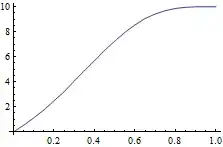Let $n>0$ and the probability for player $A$ to win a single game against $B$ be $p$.
A match consists of multiple independent games. What is the expected score-line of $A$ if the match ends when $A$ or $B$ wins $n$ games? (best-of-$(2n-1)$)
By simulation, it looks like below for $n=10$ and varying $p$, but whats the formula?
 $n=10$ as a function of $p$.">
$n=10$ as a function of $p$.">
Sounds easy, but...
Help appreciated! Thanks in advance.